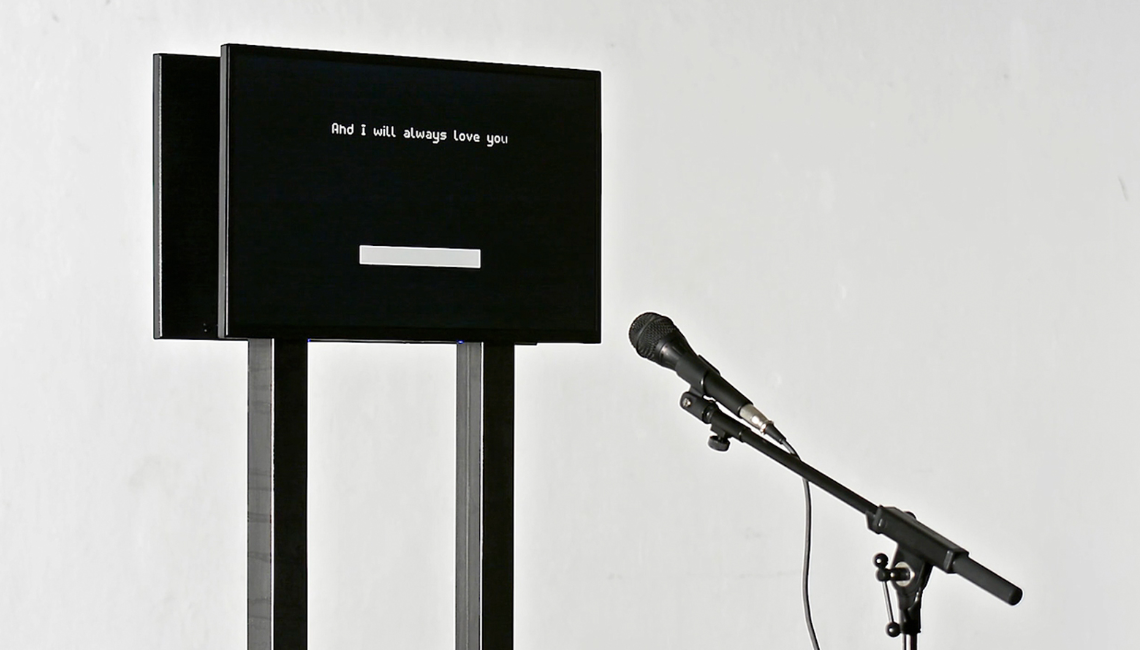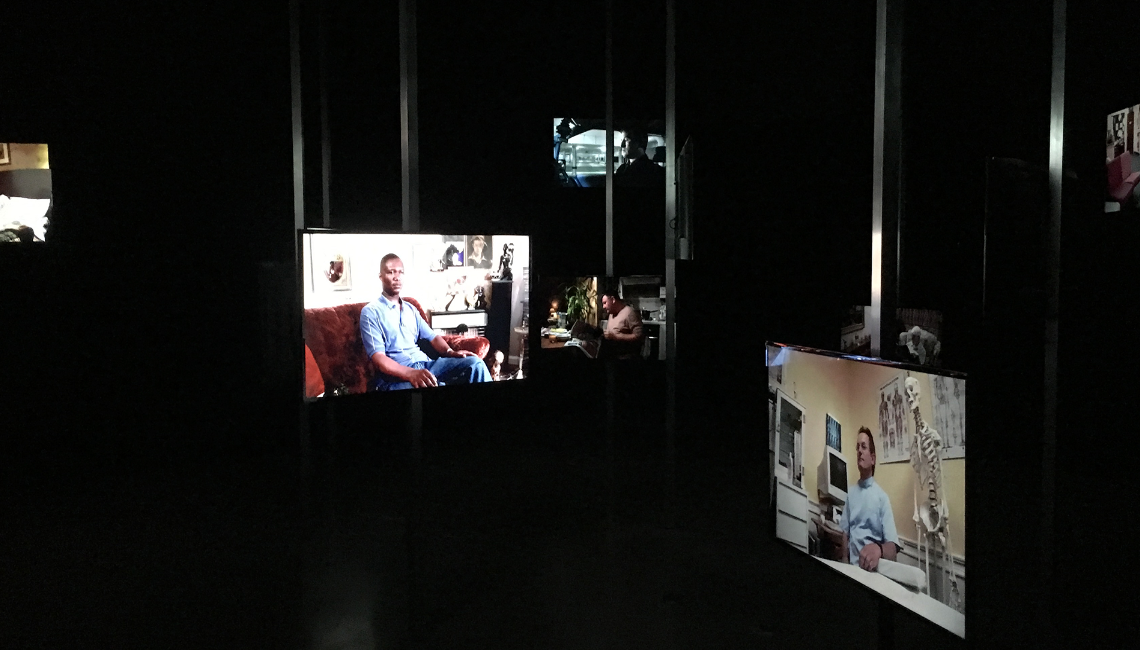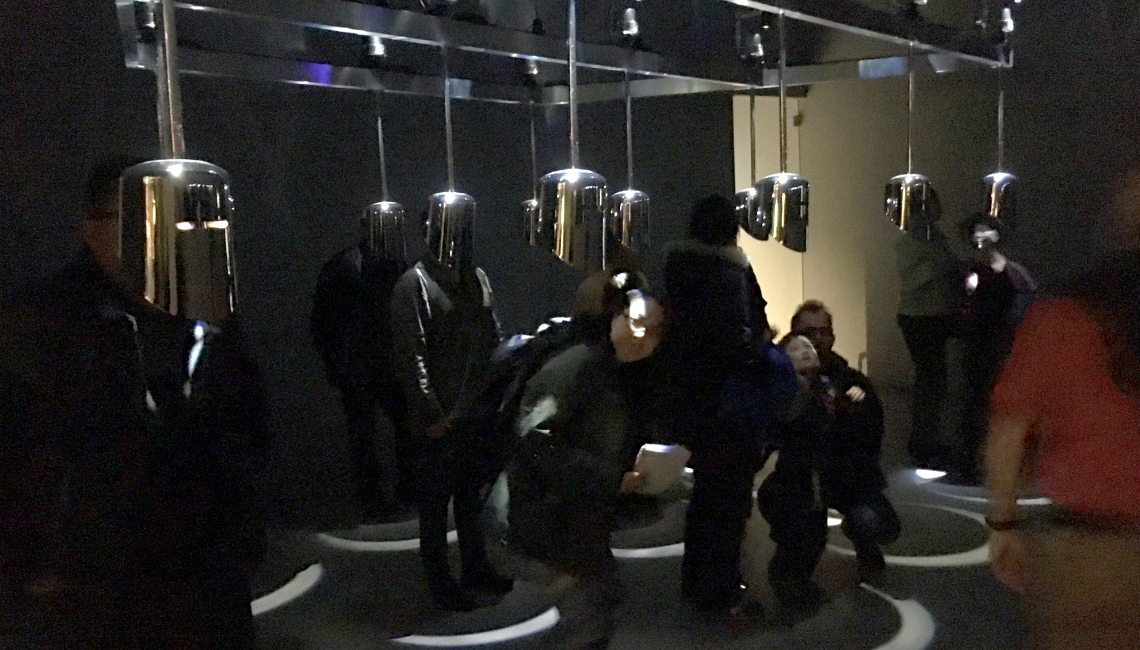V o i c i n g
O C T O B E R 2 1 - D E C E M B E R 2 2 2 0 1 7
Scholars and Scientists have long been captivated by the origins of human speech & language and how we convey emotion through voice and song. VOICING presents three artists from three countries who explore the evolution, boundaries and emotional territories of the human voice from bird song through digital code.
Voicing describes the manipulation of notes and chords in any sound-producing entity; human, bird, or instrument, thus changing the personality of this tone and altering its emotional quality. Aristotle and Darwin noticed the ability of song birds to express emotion through song, and noted the uncanny resemblance of bird song to human language. Using a remarkable process, Marcus Coates explores human language and emotion through bird song. If human language and emotional voicing have distant origins in bird song...how will the voice and song develop through code into the future?
These days scientists and artists ask ; when robots speak, how human should they sound? Robots can now recognize human emotions from tone of speech...instantaneously and in real-time. And they can emulate emotion. Martin Backes and Michelle Jaffé present two captivating works that explore the relationship between song-voice and emotion using algorithm and a program called Super Collider.
Through multi-screen video, sound, robotics & sculptural electronic media; and through the expert manipulation of code, sound and language, three award-winning artists explore, in unconventional, funny and poignant ways, the emotional qualities, origins and future of the human song-voice in a world mediated by technology.
http://newmediagallery.ca/wp-content/uploads/2017/11/voicing-long-text.pdf
Voicing describes the manipulation of notes and chords in any sound-producing entity; human, bird, or instrument, thus changing the personality of this tone and altering its emotional quality. Aristotle and Darwin noticed the ability of song birds to express emotion through song, and noted the uncanny resemblance of bird song to human language. Using a remarkable process, Marcus Coates explores human language and emotion through bird song. If human language and emotional voicing have distant origins in bird song...how will the voice and song develop through code into the future?
These days scientists and artists ask ; when robots speak, how human should they sound? Robots can now recognize human emotions from tone of speech...instantaneously and in real-time. And they can emulate emotion. Martin Backes and Michelle Jaffé present two captivating works that explore the relationship between song-voice and emotion using algorithm and a program called Super Collider.
Through multi-screen video, sound, robotics & sculptural electronic media; and through the expert manipulation of code, sound and language, three award-winning artists explore, in unconventional, funny and poignant ways, the emotional qualities, origins and future of the human song-voice in a world mediated by technology.
http://newmediagallery.ca/wp-content/uploads/2017/11/voicing-long-text.pdf
Curation + Design: Sarah Joyce + Gordon Duggan
Martin Backes (DL)
what do machines sing of?
what do machines sing of? is a modest robot, a fully automated machine, standing on a lit stage, singing Number One Love Ballads from the 1990’s. It sings without words, the intonation of each sound is laden with emotional affect. As the computer program performs these already emotionally laden songs, it attempts (through programming) to apply appropriate human sentiments where required. The artist has noted that this behavior could be interpreted as a desire, on the part of the machine, to communicate as we do: Through song to become human.
If a robot is a machine, programmable by a computer, and capable of carrying out
a complex series of actions automatically, then this is a robot. This one’s face is rendered as a digital facial emoticon so familiar to us through social media that it has become its own language The humming voice and abstract face are linked and generated by a real time synthetic programming language called SuperCollider, to mimic the pitch of whatever it is singing, and alter the appearance of the face in real time. The voice adheres closely to what we might understand as human emotional resonance. Empathic tendencies present in anthropomorphism and personification are critical to the success of the work.
Image

Biography
Martin Backes is a Berlin-based artist, creative technologist, designer, hacker and composer. He studied Media Art & Design and Sound Studies at the University of Arts in Berlin. He uses media technologies to reflect certain functionalities, effects, ideologies and differences in human perception. His experiments in art, science, technology and culture range from sculptural and multimedia sound works to interventions in public spaces, as well as radio plays and computer/video works. He shows and performs around the world.
Credits
Coming soon
Marcus Coates (UK)
Dawn Chorus
Dawn Chorus is an immersive installation. The viewer enters a room on which large monitors are positioned at different heights on steel poles. The positioning of these poles is methodical and meaningful. The sound of bird song fills the room. Marcus used unique digital methods to unpack the relationship between birdsong and the human voice. The artist worked with scientist Peter McGregor who specializes
in birdsong and animal behavior, as well as notable birdsong expert and wildlife sound recordist Geoff Sample. They spent a week living in a camper van in the Northumberland woods. Each morning they’d get up at 3 am and record bird
song on a 24 track digital recorder. Marcus was fascinated with Sample’s ability
to tell birds apart; even when some were mimicking other birds. Together they recorded 576 hours of song and a huge variety of different birds. They formed
an understanding of where to place microphones. For their final recording they captured 14 birds at the same time. In nature these birds always sing together as a dawn chorus.
Back in his Bristol studio Marcus slowed the recordings right down to a sludgey, drone of individual intonations. Then he hired amateur choir members (e.g. the ladies barbershop choir), to learn these strange riffs and sing them aloud...in their own time. The choristers were filmed at dawn, alone in their own habitat : in garden sheds, hospital waiting rooms and bathtubs. Later the film speed was increased, sometimes 16 fold, until the choristers ‘become’ birds. Monitors in the gallery replicate the positions of the microphones in the woods where that original bird dawn chorus was recorded. This Dawn Chorus is a fascinating exploration into the origins of human language and voice in bird song.
Image

Biography
Marcus Coates is a British Artist known for unusual and sometimes eccentric works that explore encounters between the human and animal worlds. He has had more than 60 solo exhibitions around the world, and has been awarded the Paul Hamlyn Foundation Artist Award and first Daiwa Foundation Art Prize. He often appropriates the language and behavior of wild animals, insects and birds as a means of deciphering our emotional and social conventions.
Credits
Coming soon
Michelle Jaffé (USA)
Wappen Field
Wappen Field is a sculpture and sound installation that is an exploration of song voice from different vocalists and cultures. This work also uses the SuperCollider Program to manipulate and modulate voice. 12 chrome-plated, steel helmets hang from the ceiling facing the visitor in a grid; their reflections cast a reflective shadow on the floor below. The human body is not immediately present but is implied. The work unites sound and body through the addition of the viewer. Jaffé has spoken of her desire to convey the presence of song and a voice that stretches into a distant past, and is in a continuous march forward. Each helmet is a resonant chamber in which a dedicated speaker transforms the helmet into an immersive and connected audio environment. Song sounds are transferred form one helmet to the next algorithmically with the help of a program called SuperCollider. The term Wappen
is the German word for Coat of Arms suggests a brand or badge identifying groups such as family, team, tribe or order.
Image

Biography
American sculptor Michelle Jaffé creates participatory installations of sculpture, sound and performance video. She first explored sound in 2000. She has exhibited widely across the U.S. Her work is found in the collections of the Philadelphia Museum of Art, Museum at FIT and Museé de la Mode in Paris.
Credits
Coming soon
